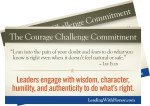Revealing the Two Distinctions of Effective Communication with Your Team Members
We often read or hear in the media about leaders whose lack of courage reaped painful consequences. But these “spectacular” failures are just the tip of the iceberg. Doubts and fears of a much smaller magnitude have caused legions of leaders to fail in less obvious ways. Although these failures don’t make the newspapers, they nevertheless can suck the energy and life out of the people and organizations they affect. By learning to listen and engage in a healthy way, I believe that many of these less-obvious failures could be avoided.
Learn to Listen
Many leaders fail to listen to the ideas, opinions, and constructive feedback of others. Some go so far as to use intimidation to silence “threatening” ideas. Still others suppress ideas by dominating conversations and not allowing others to speak. These leaders may appear “macho” on the outside, but in reality their fears and insecurities send a loud message that they don’t want anyone to disagree with their view of the world.
Unfortunately, most of us know how exhausting and demoralizing it can be to work for a leader whose tender ego must be carefully guarded. Usually there is a graveyard outside this executive’s office that’s filled with the bodies of messengers who had the courage to provide honest feedback.
If you suspect that you are this type of person, let me encourage you to get a “leadership 360 assessment,” so your direct reports, peers, and manager (or board of directors) can give you candid, anonymous feedback. (Now, that will take some real courage on everyone’s part, won’t it!) If the results indicate a problem, don’t rationalize your behaviors or demonize the messengers. Engage the issues and grow into the leader you can be, the one that your followers deserve.
When the truth is courageously communicated, people and organizations flourish. But when doubts and fears hold sway, leaders avoid hard decisions and responsible actions, and instead look for a comfortable way out.
At best, team energy drains away and people don’t grow. Too often, fear and doubt cause bad judgment that derails the leader’s influence.
The Leadership Engagement Model
Leaders who lack courage to engage problems usually veer off course in one of two directions: they will either seek to dominate, or they will seek to withdraw (fight or flight; violence or silence.) Both of these counterproductive behaviors have the same root cause: fears and doubts. I’ve found the Leadership Engagement Model™ to be extremely helpful for improving the cooperation and productivity of teams working cross-functionally, especially if a “silo mentality” is prevalent. It has also been beneficial for strategic partners who have competing interests.
For example, in most medical communities a natural tension exists between the hospital and the physicians and clinics that use the hospital. Typically, one party tries to dominate to get its way, which in turn causes the other party to become distrustful and combative.
Eventually, emotions can get so raw that one party withdraws, or they both do. To halt this vicious cycle, the two sides need to courageously commit to engage in productive dialog, identify common goals, and implement agreed-upon solutions. Meaningful engagement occurs when each party fights for its ideas in a healthy, constructive way, while still being open to the ideas of others. This type of dialog is evidence of humility, courage, and confidence. Doubts and fears are normal. You can’t avoid them, but you can manage them. You can choose to override your feelings and do the right thing.
You can choose to lean into the pain for the good of others and yourself. Like the men in the POW camps you’ve read about, you can choose to be a strong leader by being courageous.
In what specific situations might you be dominating or withdrawing (e.g., by attacking or procrastinating) when you should be engaging? What choices do you need to make to engage issues you have been avoiding? Please share your comments in this forum.
LE
~~~~
 The Leadership 360 Assessment is just of several report services available from Leadership Behavior DNA™. Leaders and team members that understand themselves and each other have an exponentially greater opportunity for success in work and business. Download a sample report, and learn more about the leadership development and report services from Leadership Behavior DNA at www.LeadershipBehaviorDNA.com
The Leadership 360 Assessment is just of several report services available from Leadership Behavior DNA™. Leaders and team members that understand themselves and each other have an exponentially greater opportunity for success in work and business. Download a sample report, and learn more about the leadership development and report services from Leadership Behavior DNA at www.LeadershipBehaviorDNA.com
 When you’re in a stressful moment and need to respond as a courageous leader, you have three ch
oices – 1. you can withdraw | 2. you can dominate | 3. you can engage
When you’re in a stressful moment and need to respond as a courageous leader, you have three ch
oices – 1. you can withdraw | 2. you can dominate | 3. you can engage
What’s the difference between these choices? We invite you to apply the Leadership Engagement Model in the Courage Challenge. Learn More






